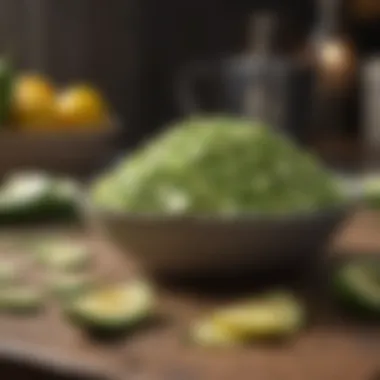Is Zucchini a Healthy Choice for Your Dog's Diet?


Intro
Exploring dietary options for pets is crucial for pet owners looking to maintain their dogs' health. Zucchini is often considered a healthy addition to a dog's diet, but is it truly beneficial? This article will dive into the nutritional value of zucchini, outline potential risks, and discuss safe preparation methods. A thorough understanding will help pet owners make informed choices.
Nutritional Benefits of Zucchini
Zucchini is low in calories and high in water content, making it a great treat for dogs. It is rich in essential vitamins and minerals such as vitamin C, vitamin A, potassium, and fiber. These nutrients are important as they contribute to a dog's overall health. Fiber aids in digestion, while vitamins support the immune system.
Zucchini also contains antioxidants that can help combat oxidative stress, an issue that can affect dogs' longevity and wellness. The high water content of zucchini ensures hydration, especially during the warmer months.
Owners should consider incorporating zucchini into their dog's diet as an occasional treat rather than a daily meal. Whether sliced, diced, or pureed, zucchini can be a nutritious addition that provides variety.
Potential Risks Associated with Zucchini
While zucchini is generally safe for dogs, there are some risks to be aware of. Firstly, the skin of the zucchini can be tough for some dogs to digest. It is best to remove it before feeding, especially for dogs with sensitive stomachs. Furthermore, excessive consumption can result in gastrointestinal discomfort. It is advisable to introduce zucchini slowly to monitor any adverse reactions.
More importantly, any form of zucchini must be cooked before serving. Raw zucchini can cause a blockage in small dogs if they bite into large pieces. Always chop zucchini into appropriate sizes that fit comfortably in a dog's mouth.
Safe Preparation Methods
Preparing zucchini for dogs is straightforward. Here are some effective methods to prepare zucchini:
- Boiling: Cook zucchini in water until tender.
- Steaming: Use a steamer to keep nutrients intact while softening the vegetable.
- Baking: Cut into pieces, drizzle with a small amount of olive oil, and bake until soft.
Ensure that no herbs, spices, or seasonings are added, as some can be harmful to dogs. Before feeding, it is prudent to let it cool to a safe temperature.
Veterinary Insights and Recommendations
Veterinarians often suggest zucchini as a healthy, low-calorie treat for dogs. It provides essential nutrients that can enhance a dog's diet, particularly for those that may need to lose weight or require extra fiber. Balanced with regular dog food, zucchini can support overall health and keep dogs active. Veterinarians also recommend monitoring how dogs react to new foods and consulting professionals if any adverse effects occur.
Closure
Preamble to Zucchini and Dogs
Understanding the dietary needs of our canine companions is crucial for their overall health. The topic of incorporating zucchini into a dog’s diet raises important considerations. Zucchini, a vegetable rich in various nutrients, offers potential benefits, but it is essential to understand both its advantages and limitations when feeding it to dogs.
Understanding Zucchini
Zucchini, also known as courgette, is a summer squash. It belongs to the Cucurbita pepo family and is recognized for its mild flavor and versatile use in dishes. This vegetable is often celebrated for being low in calories while packed with vitamins and minerals. For dogs, these properties can supplement their diet if introduced properly.
Zucchini is primarily composed of water, which can help keep dogs hydrated. Additionally, it contains essential vitamins such as Vitamin A and Vitamin C, as well as minerals like potassium. However, while it can be healthy, understanding the proper way to introduce this vegetable to dogs is necessary to avoid any adverse reactions.
Dogs’ Nutritional Needs
Dogs have specific nutritional requirements that differ from humans. They need a balanced diet that provides them with proteins, fats, carbohydrates, vitamins, and minerals. While dogs are omnivores and can eat vegetables, not all veggies are suitable for canine consumption.
When considering zucchini, owners should be aware that any addition to a dog's diet must align with their nutritional needs. For instance, dogs need high-quality proteins to maintain their energy and muscle mass. Hence, vegetables like zucchini should complement, rather than replace, their primary food sources.
There are also considerations regarding portion sizes. Zucchini can be a helpful treat or supplement but should not exceed a certain amount. Too much of any new food can lead to digestive issues. Always start with small amounts to see how well a dog tolerates it before making it a regular addition. Proper knowledge about both zucchini and canine nutrition facilitates a responsible approach to their diet.
Nutritional Benefits of Zucchini for Dogs
Zucchini offers various nutritional benefits for dogs. Understanding these factors is crucial for dog owners considering its incorporation into their companion's diet. Zucchini is low in calories, which is significant for pets prone to weight gain. The presence of vitamins and minerals enhances overall health, making this vegetable an appealing addition to canine meals. Furthermore, its high water content can assist in keeping dogs hydrated.
Vitamins and Minerals


Vitamin A
Vitamin A plays a vital role in maintaining healthy eyesight and immune function in dogs. It is essential for skin health and may prevent certain infections. The characteristic of Vitamin A is that it promotes good vision, particularly in low-light conditions. This vitamin is beneficial in preventing issues like night blindness, which can affect older dogs. The unique feature of Vitamin A is its antioxidant properties, aiding in cellular function and protection against harmful free radicals.
Vitamin
Vitamin C is another critical vitamin found in zucchini. This vitamin enhances the immune system and helps in the production of collagen, which is vital for maintaining skin and joint health. One key characteristic of Vitamin C is its ability to combat oxidative stress, which can deteriorate a dog's health over time. Although dogs can synthesize vitamin C, providing extra through dietary sources like zucchini may offer additional support, especially for aging dogs with weakened immune systems. Its antioxidant effect is a considerable advantage, although some might argue that excessive amounts could cause gastrointestinal upset.
Potassium
Potassium is an essential mineral required for maintaining proper muscle and nerve function in dogs. It aids in regulating heart function and helps balance fluids in the body. A notable characteristic of potassium is its critical role in maintaining electrolyte balance, which is key for an active and healthy lifestyle. Incorporating zucchini into a dog's diet can provide this mineral, supporting overall health. However, there is a cautionary point; too much potassium can lead to health complications, making moderation vital.
Low-Calorie Snack Option
Zucchini serves as a low-calorie snack option for dogs. Its low caloric content helps in managing a dog's weight, especially in breeds that are prone to obesity. By offering zucchini as a treat, pet owners can reduce calorie intake from other higher-calorie snacks, ensuring their pets remain fit. Since many dogs enjoy the crisp texture of raw zucchini, it can be a satisfying substitute for less healthy alternatives, facilitating better overall health.
High Water Content
The high water content in zucchini is another significant benefit. It can assist in hydration, especially in hot weather or after exercise. Proper hydration is crucial for optimal health, as it supports essential bodily functions. Including zucchini in your dog's diet can help ensure that they take in adequate fluids. However, pet owners should remember that while zucchini contributes to hydration, it should not be the sole source of a dog's water intake.
Potential Risks of Feeding Zucchini to Dogs
When considering zucchini as a dietary option for dogs, it is essential to explore the potential risks associated with its consumption. While these risks can vary based on individual dog health and the amount of zucchini fed, understanding them helps dog owners make informed choices for their pets. This section will outline the potential digestive issues, allergies, and pesticide exposure that can arise from feeding zucchini to dogs.
Digestive Issues
Diarrhea
Diarrhea can occur when a dog consumes an excessive amount of zucchini. This condition is characterized by loose or watery stools. Dogs' digestive systems can be sensitive, and introducing new foods requires caution. Diarrhea, in the context of zucchini, can be seen as a direct response to the fiber content present in the vegetable. While fiber is beneficial for digestion, too much can overwhelm a dog's gut, leading to gastrointestinal upset.
When dogs have diarrhea, it can lead to dehydration and a loss of essential nutrients. This makes it crucial for dog owners to monitor their pets after introducing zucchini to their diet. It is advisable to start with small portions and observe their reaction closely. The minor disadvantage of diarrhea in relation to zucchini is that it may discourage owners from trying healthy options like vegetables altogether, despite their nutritional benefits.
Bloating
Bloating is another potential issue when feeding zucchini to dogs. This condition is characterized by an uncomfortable swelling of the abdomen, often caused by gas accumulation. Zucchini can introduce gas into the gastrointestinal tract, especially if it is fed in large amounts. Bloating itself is not just uncomfortable; it can also lead to a serious condition known as gastric torsion if it occurs frequently or severely.
Understanding that bloating can arise from adding zucchini to a dog's diet is essential for responsible pet ownership. It highlights the need for gradual introduction of new foods. While bloating can be managed by controlling portion sizes and avoiding sudden dietary changes, pet owners should be alert to any signs of discomfort. This unique feature of bloating underscores the importance of moderation when it comes to treats and snacks like zucchini.
Allergies and Sensitivities
Dogs can develop allergies or sensitivities to various foods, and zucchini is no exception. Though it is not one of the most common allergens, some dogs can have adverse reactions. Symptoms may include itching, skin rashes, or even gastrointestinal disturbances. Identifying an allergy can be challenging, as symptoms may take time to appear after consumption.
Before adding zucchini to a dog's diet, it is prudent to consult with a veterinarian, especially for dogs that have a history of food sensitivities. A gradual introduction allows owners to monitor any adverse effects. If signs of an allergy appear, it is wise to discontinue feeding zucchini and seek advice from a professional.
Pesticide Exposure
Pesticides can pose a risk to dogs when zucchini is not properly washed or cooked. Many zucchinis are treated with chemicals to protect them during growth. Residual pesticide on the skin can enter a dog's system, potentially causing health issues. To mitigate this risk, it is crucial to wash zucchini thoroughly before preparing it for your dog. Organic zucchinis are also a safer alternative as they are less likely to contain harmful pesticides.
How to Safely Prepare Zucchini for Dogs
Preparing zucchini carefully for dogs is crucial to maximize its health benefits while minimizing any potential risks. Proper preparation ensures that the zucchini is safe and digestible for canine consumption. This section will guide you through essential steps and considerations in safely preparing zucchini for your pet.
Washing and Peeling
Before preparing zucchini for dogs, washing is an important step. Rinse the vegetable thoroughly under running water to remove any dirt, bacteria, or pesticide residues. Zucchini skin can harbor harmful substances, so cleaning it well is critical. After washing, peeling is optional. While the skin is rich in fiber and nutrients, some dogs may find it harder to digest. If your dog has a sensitive stomach or if you are unsure, peeling the zucchini can be a good choice.


Cooking Methods
Choosing an appropriate cooking method is vital to maintain the nutritional quality and safety of zucchini for dogs. Here are three main ways to prepare zucchini:
Steaming
Steaming zucchini helps retain most of its nutrients, making it a popular cooking method for dog owners. This method involves cooking the zucchini over boiling water, allowing steam to heat the vegetable without direct contact with the water. One key characteristic of steaming is that it softens zucchini's texture, making it easier for dogs to chew. This is especially beneficial for older dogs or those with dental issues.
The unique feature of steaming is that it preserves vitamins like Vitamin C, which can be lost through other cooking methods like boiling. However, it’s prudent to avoid overcooking, as this can lead to nutrient loss.
Boiling
Boiling is another common method, but it may not be as beneficial as steaming. This method involves submerging zucchini in water and cooking until tender. While boiling can make zucchini soft and easier to chew, it often results in a loss of essential nutrients, especially if the water is discarded afterward.
A unique feature of boiling is its simplicity, but you should be aware of the potential downsides. The water used during boiling absorbs some of the vitamins, which means your dog may not receive the full nutritional benefit.
Raw
Feeding raw zucchini is an option that some pet owners choose. This method offers the advantage of retaining all nutrients, which is perfect for dogs needing high-fiber foods. Raw zucchini can be sliced or diced and offered as a treat or mixed into meals.
However, this method may not be suitable for every dog. Some dogs may experience digestive discomfort from raw vegetables, particularly if they are not used to them. Observing your dog's reaction to raw zucchini will help you determine if this is a safe option.
Properly preparing zucchini for dogs requires attention to detail in washing, peeling, and selecting the best cooking method. Each cooking approach has its benefits and drawbacks, and understanding these can lead to a healthier diet for canine companions.
Incorporating Zucchini into Your Dog's Diet
Incorporating zucchini into your dog's diet can be an interesting venture. It can provide not only nutritional benefits but also contribute to variety in your pet's meals. Zucchini is low in calories, which makes it suitable for dogs that may need to manage their weight. Adding vegetables like zucchini can enrich a dog's diet with essential vitamins and minerals, as well as helpful fiber.
Furthermore, some dogs can be finicky eaters, and introducing new foods like zucchini may encourage them to try new flavors and textures. However, one must consider how to add zucchini safely to the dog's diet. This section will discuss how to approach incorporating zucchini in a balanced manner.
Portion Size Considerations
The portion size is crucial when introducing zucchini to your dog. Too much can lead to gastrointestinal upset, while too little might not yield the desired benefits. A good rule of thumb is to start with small amounts. For example, a few small slices or a tablespoon of pureed zucchini can be a good starting point.
Monitor your dog's reaction and adjust the portions accordingly. Generally, larger dogs can have more compared to smaller breeds. It's essential to observe how your dog interacts with this new addition. If your dog enjoys the zucchini and shows no signs of discomfort, you can gradually increase the quantity.
Mixing with Other Foods
Dog Food
Mixing zucchini with dog food can provide a great way to enhance the nutritional value of your dog's regular meals. The combination can create a more appealing dish that also offers more fibers and vitamins. Many reputable commercial dog food brands already include vegetables in their formulas. Therefore, integrating zucchini can complement the existing nutrition profile. It's beneficial as it stimulates interest in the food.
Homemade Treats
Creating homemade treats with zucchini can be a fun and beneficial way to include this vegetable in your dog's diet. These treats usually do not contain fillers or preservatives found in commercial varieties. Using plain zucchini, perhaps combined with other safe ingredients, creates healthy options for your dog. Homemade treats allow for more control over the ingredients used, ensuring your pet receives a wholesome snack. However, care must be taken to maintain a balance of nutrients while preparing these treats. It is prudent to consult resources or experts on optimal ingredient combinations to avoid potential dietary issues.
Veterinary Insights on Feeding Zucchini to Dogs
Veterinary insights on feeding zucchini to dogs provide a critical perspective for pet owners. Understanding the role of vegetables in a dog’s diet can lead to healthier choices. Veterinarians have specific knowledge regarding canine nutrition, related risks, and benefits. They consider factors like a dog’s size, breed, age, and any pre-existing health conditions before making recommendations.
Moreover, insights from veterinary professionals help mitigate the likelihood of adverse reactions linked to introducing new foods. Each dog is unique, and what works well for one may not be suitable for another. Thus, consulting with a veterinarian before introducing zucchini into a dog’s diet is essential.
Expert Recommendations
Veterinarians often recommend that zucchini can be a safe addition to a dog’s diet when prepared properly. They advise starting with small amounts. This allows you to monitor the reaction without overwhelming the dog’s system. Some key recommendations include:


- Preparation: Wash zucchini thoroughly to remove any pesticides or dirt. Peeling may not be necessary but can reduce the risk of digestive issues for sensitive dogs.
- Cooking: Steaming or boiling zucchini before serving can make it easier for dogs to digest. Raw zucchini is also safe if introduced slowly.
- Portion Control: Zucchini should not replace a balanced diet. Instead, it can be a healthy treat. Limit servings based on the dog's size and dietary needs.
Veterinarians also emphasize the importance of varied diets. This ensures that dogs receive a wide range of nutrients. Foods that complement zucchini can enhance overall health and well-being.
Case Studies and Examples
Veterinary case studies show varied responses to zucchini in dog diets. In one case, a medium-sized dog was introduced to zucchini gradually. The owner noted the dog thrived, showing increased energy and improved coat condition. This outcome aligns with the vegetable's high nutritional value.
Conversely, another case involved a dog with pre-existing gastrointestinal issues. Upon introducing zucchini, the owner reported increased gastrointestinal upset. This highlighted the importance of considering individual health concerns before altering a dog's diet.
Each case underscores the concept that while zucchini has benefits, it is not universally suitable for every dog.
Continuous monitoring and open communication with veterinarians can help navigate dietary changes safely.
Engaging veterinary care is vital for assessing dietary adjustments and ensuring your dog's health remains in focus.
Alternatives to Zucchini for Dogs
Feeding dogs a variety of fresh produce can enhance their diet and ensure they receive necessary nutrients. While zucchini is a good option, exploring alternatives provides choices for dog owners looking to diversify their pet's meals. Substituting different vegetables and fruits can help meet your dog's nutritional needs and can also prevent dietary boredom.
Other Vegetables
Carrots
Carrots are often recognized for their high fiber content and low calorie count. This characteristic makes them a favorable option for dogs. They are also a natural source of beta-carotene, which is essential for maintaining a healthy coat and promoting good eyesight. Carrots can be given raw or cooked, providing versatility in preparation. The crunchiness of raw carrots may also help clean dogs' teeth. However, some dogs might find raw carrots challenging to chew. Thus, cutting them into smaller pieces can help avoid choking hazards.
Green Beans
Green beans stand out as another excellent snack for dogs due to their low calories and high fiber. They can be prepared in a variety of ways, including steaming or boiling. This ease of preparation makes them accessible for dog owners. Green beans also contain essential vitamins like vitamins K and C. Dogs typically enjoy the texture and taste of green beans, making it a popular choice among pet owners. As with carrots, portion control is important as excessive intake can lead to digestive upset.
Fruits Safe for Dogs
Apples
Apples are a well-liked fruit for dogs because they are packed with vitamins A and C, making them beneficial for immune health. The crisp texture can help clean teeth and freshen breath. When feeding apples, it is crucial to remove the seeds and core as they can be harmful. Slices of apples can be a refreshing treat on a hot day. Despite their benefits, some dogs may be sensitive to fruits, so monitoring for any allergic reactions is wise.
Blueberries
Blueberries are rich in antioxidants, which can support overall health and fight against cell damage. Their small size makes them easy to serve, and many dogs enjoy their flavor. Blueberries can be a healthy addition to homemade treats or given as a snack during training. However, it is advisable to limit the amount given at a time due to their sugar content. Excessive sugar intake, even from fruits, can lead to health issues in dogs.
"Incorporating a variety of vegetables and fruits can provide your dog with essential nutrients and keep their meals interesting."
Ending
The examination of zucchini as a potential addition to a dog's diet presents an important topic for pet owners. This article underscores the nutritional benefits, such as vitamins and hydration, while also shedding light on possible risks like digestive issues and allergies. It is crucial for dog owners to understand both sides before making dietary changes.
The incorporation of zucchini in a dog's meals can offer a low-calorie, high-water snack option. However, it demands careful preparation and moderation. Pet owners must be vigilant about the signs of allergies or digestive disturbances. Learning to wash, peel, and properly cook zucchini ensures that it remains safe for their furry companions.
Veterinary insights provide a well-rounded perspective, reinforcing the need for responsible feeding practices. Consulting with a veterinarian can help tailor dietary choices to an individual dog's needs, mitigating concerns over potential risks.
In summary, introducing zucchini to a dog's diet can be beneficial if approached with caution. Balancing the advantages against any risks leads to informed decisions that enhance a dog’s health and quality of life.
Summary of Key Points
- Zucchini provides vitamins A and C, along with potassium, which supports a dog’s overall health.
- It is a low-calorie snack option, beneficial for dogs needing to manage their weight.
- The high water content aids hydration in dogs, especially in hot conditions.
- Potential risks include digestive issues like diarrhea and bloating, and possible allergic reactions.
- Proper preparation techniques include washing, peeling, and cooking to minimize pesticide exposure and improve digestibility.
- Portion control is necessary to avoid adverse effects, while mixing zucchini with other safe foods can enhance meal appeal.
Final Thoughts on Zucchini for Dogs
Zucchini can be a great addition to a dog’s diet but requires cautious implementation. This humble vegetable brings various nutrients that can promote wellness. However, the discussions around nutrition should also include considerations of individual health conditions, allergies, and appropriate serving sizes.
To sum up, when included thoughtfully within a balanced diet, zucchini may offer dogs a tasty, nutritious treat. Being aware of both the benefits and risks helps pet owners make educated decisions, ultimately leading to a healthier dog. For more information, consult veterinarian resources or reputable guides.
"Before introducing any new food into your dog's diet, always consult your veterinarian to ensure it aligns with their health needs."







